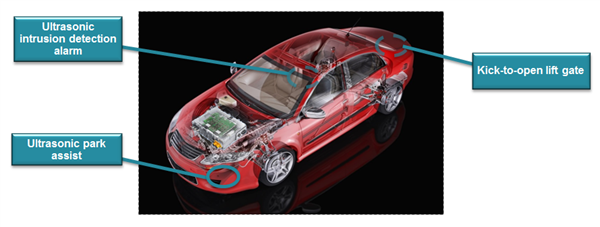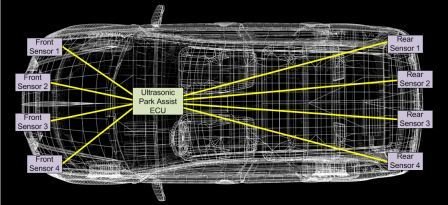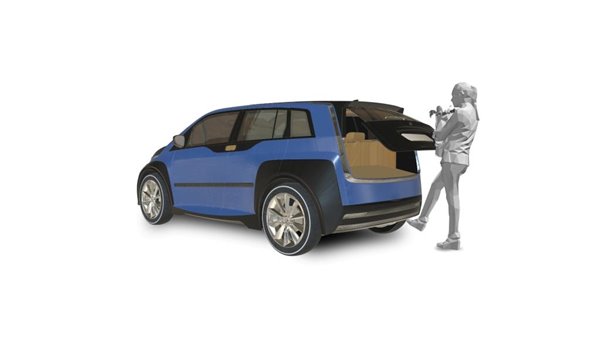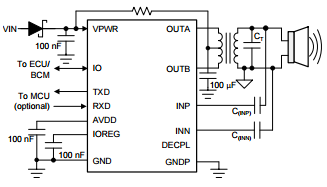SSZTA28 June 2017 PGA460 , PGA460-Q1
Ultrasonic sensors have been used in passenger vehicles for many years in applications like ultrasonic park assist, which help vehicles detect objects at low speeds when parking. However, kick-to-open liftgates and intrusion detection alarms are two other emerging applications for ultrasonic sensors; see Figure 1. In this post, I will explain why – and how – all three applications use ultrasonic sensors.
 Figure 1 Ultrasonic Sensors in
Passenger Vehicles
Figure 1 Ultrasonic Sensors in
Passenger VehiclesUltrasonic Park Assist
 Figure 2 Ultrasonic Park Assist Star
Configuration Using the PGA460-Q1
Figure 2 Ultrasonic Park Assist Star
Configuration Using the PGA460-Q1Engineers designing these types of applications should seek out integrated circuits (ICs) driving an ultrasonic transducer (transmitter) while receiving, conditioning and processing the ultrasonic echo that determines the distance of an object from the vehicle. For example, the PGA460-Q1 can reliably detect an International Organization for Standardization (ISO) pole (polyvinyl chloride [PVC] pipe used in ultrasonic park assist as a performance standard) up to 5m away. The device has also passed stringent electrostatic discharge (ESD) and bulk-current injection (BCI) testing – common tests performed during ultrasonic park assist system developments.
Ultrasonic park assist cost pressures will continue to increase over the next several years as original equipment manufacturers (OEMs) face the need to add more ultrasonic sensors per vehicle. The PGA460-Q1 supports a competitive cost structure for high-volume Tier-1 suppliers.
Common requirements in ultrasonic park assist modules include:
- Object detection from 30cm to 5m.
- Time command interface (TCI) or Local Interconnect Network (LIN) communication from the module to a local electronic control unit (star configuration) or directly to the body control module (BCM) (bus configuration).
In order to meet the needs of autonomous vehicles, short- and long-distance object-detection standards will become more stringent. Beginning around 2025, ultrasonic modules will have to detect objects from 10cm to 7m away. Improvements in analog front end (AFE) sensitivity and drive methods by semiconductor suppliers will be crucial in meeting these distance requirements.
TCI and LIN are the two most common communication interfaces in ultrasonic park assist systems today. However, as vehicles advance in their advanced driver-assistance system (ADAS) vision-processing abilities, expect the use of higher-speed protocols like Peripheral Sensor Interface (PSI) 5, Distributed Systems Interface (DSI) 3 or Controller Area Network (CAN) to communicate larger amounts of ultrasonic echo data.
Kick-to-open Liftgates
 Figure 3 Kick-to-open Lift Gate
Figure 3 Kick-to-open Lift GateTraditional kick-to-open liftgate systems used capacitive sensing strips located across the bottom of the bumper. However, many automotive Tier-1 suppliers are exploring ultrasonic sensing for this application, with some systems already in mass production. The advantage of ultrasonic sensing vs. capacitive sensing is the latter’s reliability and robustness against environmental factors such as dirt and water compared to capacitive sensing, which is very sensitive to environmental factors and may not work when a car is dirty.
Common requirements in ultrasonic solutions for kick-to-open systems include:
- The ability to detect objects from 15cm-1m away.
- Low quiescent current.
- The ability to operate off of a 12V car battery supply.
Let’s break down each of these requirements.
Object Detection from 15cm-1m Away
The method and design of the transducer driver can also significantly impact the ultrasonic decay period and profile. In kick-to-open applications requiring near-field performance, TI recommends using a transformer drive topology. Figure 4 is an example transformer drive schematic using the PGA460-Q1.
 Figure 4 PGA460-Q1 Transformer Drive Schematic
Figure 4 PGA460-Q1 Transformer Drive SchematicWhen using a transformer to increase the supply voltage to excite the transducer, the decay profile is more predictable and less “choppy,” resulting in better near-range object-detection performance.
Finally, the performance of the AFE and digital processing affect near and far object detection. For example, the PGA460-Q1 has a low-noise amplifier followed by a programmable time-varying gain stage feeding into a 12-bit successive approximation register analog-to-digital converter. The low-noise amplifier reduces noise from the received signal, and the programmable gain amplifier’s time-varying gain feature enables small gain applied to near-field objects and larger gain for far-field object detection. You can set the gain profile settings in the register for storage in electrically erasable programmable read-only memory (EEPROM).
Low Quiescent Current
Ability to Operate off of a 12V Car Battery Supply
Intrusion Detection Alarms
Conclusion
Additional Resources
- Order the PGA460-Q1 evaluation module (EVM).
- Watch PGA460-Q1 EVM training video series.
- Download the PGA460 frequently asked questions (FAQ) and EVM troubleshooting guide.
- Download the PGA460 ultrasonic module hardware and software optimization application report.